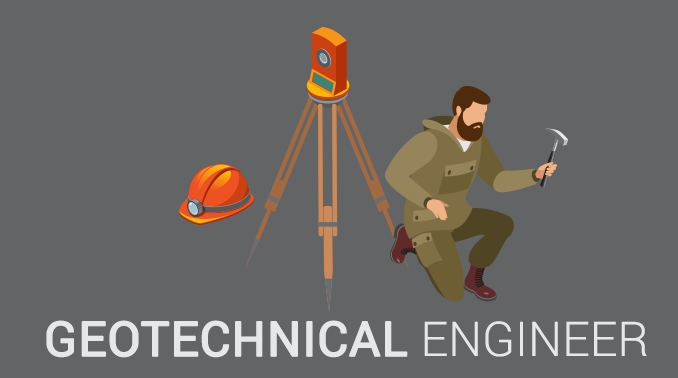The Geotheta PDFs
Table of ContentsThe Facts About Geotheta RevealedGetting The Geotheta To WorkGetting My Geotheta To WorkHow Geotheta can Save You Time, Stress, and Money.
They team up with civil engineers, architectural designers, architects, and various other specialists to integrate geotechnical considerations into the overall task style and building process. This requires effective synergy, sychronisation, and communication to make sure that the geotechnical aspects straighten with the job objectives and fulfill regulative requirements.Mining & Materials Design: Concepts of boring, infiltration prices, and aspects impacting the choice of exploration technique. Blowing up techniques in surface and below ground workings. Mechanical and continuous techniques to fragmentation, consisting of longwall shearing and fullface boring.
Modelling of fragment and bit dimension distributions; comminution as a transfer function. Comminution modern technology: squashing, grinding, size classification. Integrated evaluation of fragmentation and comminution procedures. Offered by: Mining & Materials Engineering.
10 Easy Facts About Geotheta Shown
Bachelor's degree programs in civil, geotechnical, geological, and environmental design commonly last 4 years and consist of basic education training courses in English, social science, and the liberal arts, in addition to training courses in advanced maths, structural geology, and liquid mineralogy. (https://old.bitchute.com/channel/GgOXLypkqwPa/)
Geotechnical engineering entails the assessment of the soil and rock problems at a particular site, and their implications for the growth of that site. As many frameworks depend on the ground for support, it lacks surprise that a comprehensive understanding of the ground conditions, and the viability of structure systems, are vital to the long-lasting security and efficiency of the building or framework.
Specialising in the investigation of geological developments and ground behaviour, geotechnical designers execute scientific investigations and testing to recognize the influence these geological developments might carry the layout and construction of building, civil and facilities jobs. This experience is essential for the style and building and construction of buildings, roads, passages, dams, bridges, and water and sewer systems.
The geotechnical team at Douglas Partners consistently seek advice from with engineers, design engineers, designers, and contractors to make referrals on layout and growth propositions to ensure that the constructed frameworks are suitably created for the ground problems. The design of footing systems requires to think about the weight of the framework, the capability of the ground to support that weight together with activity resistances and effective building.
Facts About Geotheta Revealed
This job is substantially streamlined by the use of our Douglas Map geospatial platform which makes this details conveniently easily accessible in an easy to make use of web internet browser interface. A geotechnical designer will certainly direct the boring of boreholes and examination pits to collect soil and various other examples, and also analyze surface area features and ground exposures to create a geotechnical model of the subsurface conditions.
Relying on the project type and ground problems experienced, research laboratory testing may amongst other things examine toughness, compressibility, reactivity and/or permeability of soil and rock samples. After this information is accumulated and collated, the results are used for a geotechnical model of the site, which is commonly offered as areas throughout the website.

A geotechnical examination naturally can just assess the ground conditions at the locations drilled or excavated. Natural variations in soil and rock conditions can occur throughout a website and between examination areas. It is as a result excellent practice that the geotechnical engineer be kept throughout building of the project to offer on-site verification that the ground conditions encountered are constant with the expectations and guidance supplied in the geotechnical investigation report.
Our Geotheta Ideas
Geotechnical designers use their extensive knowledge of dirt and rock to examine risk and solve troubles on diverse framework projectsGeotechnical engineering is a specialist branch of civil design which considers the practices of earth products and the application of soil and rock mechanics. Geo Tech Engineer. As a geotechnical engineer, you will analyze the physical, mechanical and chemical properties of dirt and rock in order to make foundations, keeping structures and earthworks
Geotechnical design is carefully linked to and overlaps with, both design geology and ground engineering - https://yoomark.com/content/httpsgeothetacom. It's possible to specialise in geotechnics or help a geotechnical company however be called an engineering rock hound or a ground engineer. As a geotechnical designer, you'll require to: construct and preserve relationships with clients and other experts associated with the website, throughout each projectmaintain safety requirements on site be conscious of price ramifications when you make recommendationsstudy geological maps and airborne photos from an array of resources and from various time periodsexamine building intends to see exactly how feasible they are based upon your understanding of the siteinvestigate threats or geological hazards for the sitesearch for eco sensitive attributes, such as landfill begin to develop accurate and interpretive ground modelsplan field investigationsdrill and evaluate samples of bedrock, dirt, groundwater and additional products monitor various other professionals on sitesolve technological concerns as they occur, such as unanticipated structures at drill sitesmonitor conditions throughout and after construction to ensure frameworks are see steady in the brief and lengthy termadding data accumulated on site to your initial researchcreating geotechnical estimations, drawings, and two or three-dimensional computer designs interpreting the datamaking suggestions regarding the recommended usage of the site
